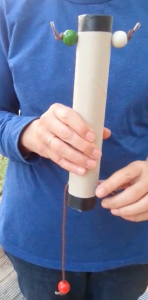My mystery tube blog post seems to have inspired a lot of people. How awesome! This is what my parents sent me:
And my friend Kristin Richter took the whole thing to the next level: She brought the mystery tube in to work and tested it on colleagues! And when we were discussing the mystery tube in the context of a possible workshop we wanted to run, she came up with a great context.
— spoiler alert – don’t continue reading if you haven’t figured out how the mystery tube works! —
So the thing is: In all instructions the two threads inside the tube are connected with a ring through which they are both fed. When I built my own mystery tube, I was too lazy and to cheap to put a ring inside a mystery tube where it a) wasn’t visible and b) not even necessary. My solution was instead to just cross the two threads and the result is exactly the same. So Kristin pointed out that this is actually a really cool feature of the mystery tubes when we use them to model a model. A model might reproduce the behavior of a system perfectly (like my cheap mystery tube reproduces all the functionalities of a “real” mystery tube with a ring inside), yet we do not know if it does reproduce reality for the right reasons. New scenarios might develop – for example if we shook the mystery tubes, one might make a noise and the other one might not – but still. What if one ring was made out of a material that did not make a sound when hitting the walls of the tube? We’ll never know whether there is a “ring” in the real world or not.
Did the mystery tubes get even more awesome now or what? :-)
